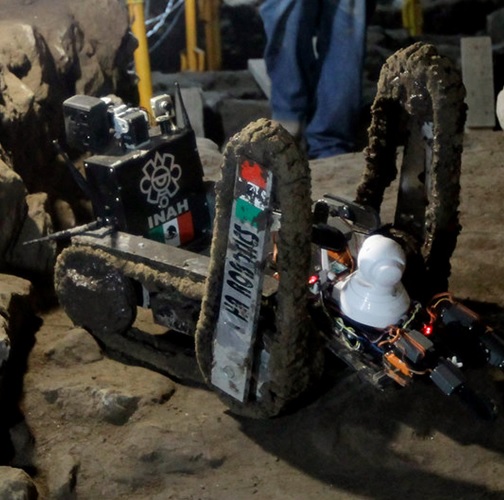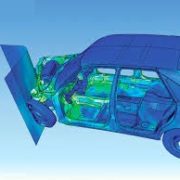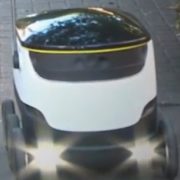File this under things that make America great. Evidently, some big box stores sell impressively sized barrels of a food-like substance called “cheese balls.” No one can figure out what to do with them (eating them is apparently out of the question). A YouTube enthusiast, NightHawkInLight, has an extensive video channel featuring do-it-yourself projects, such as making […]
AMREL is always on the lookout for new applications for Unmanned Ground Vehicles (UGV), since we are the premier supplier of Operator Control Units for them. Bomb detection, guard duty, and farming are well-known uses for UGVs. To this list, we can add unlocking the secrets of a lost civilization.
For over 100 years, archeologists have been exploring the ruins of Teotihuacan, a location outside of Mexico City. Famous for its huge pyramids, it once housed 100,000 to 200,000 people, making it one of the largest cities in the world at that time. Almost nothing is known about the original inhabitants or why they inexplicably disappeared.
After a heavy rainstorm, Sergio Gomez, an archeologist who has devoted his career to studying the Teotihuacan ruins, noticed a sinkhole at the base of one of the pyramids. In best Indiana Jones fashion, he lowered himself by rope into the mysterious hole. No word about whether he wore a fedora or carried a whip. Nor were there any reports of snakes or giant rolling stone balls.
He descended approximately 45 feet into the dark, unknown, never-explored opening. Was he scared? According to him, he was terrified. However, at the end of descent, he discovered something that made the trip worthwhile; a man-made tunnel. Around 100 yards long, this underground passage eventually yielded 75,000 artifacts including seashells, animal bones, jewelry, pottery, rubber balls, obsidian knives, and green stone statuettes.
Excavation of the final end of the tunnel was critical. Located deep beneath the Temple of the Plumed Serpent, it was thought to hold vital information about the purpose of the tunnel, as well as pyramids themselves.
However, the tunnel narrowed significantly toward the end; no person could crawl through it. Using traditional mining techniques were out of the question, since they were too likely to damage the sensitive archaeological site.
Fortunately a university in Mexico City had a solution. Named for Aztec rain gods, Tlaloque and Tláloc II were two UGVs that had previously been used to explore Teotihuacan. A similar UGV had been used in an Egyptian tomb.
A 4×4 traction vehicle, Tlaloque 1 is only 20 cm in height, 30 cm wide, and 50 cm long. Located one at the back and one at the front, Its 2 remote-controlled camcorders can do 360 degree turns. It has its own lights and transmits images to an external computer monitor.
The larger meter-length Tláloc II is equipped with heavy duty tires, designed to navigate wet, muddy soil. Its meter-length mechanical arms, can chew through earth and clear obstacles. Equipped with bright lights as well as video cameras, it stores images on an on-board hard drive. It uses a laser to scan the topography. Unlike Tlaloque 1, Tláloc II is remote controlled by wireless means and carries an independent “insect” robot that has an infrared camera. Both the Tláloc II and the “insect” robot can be seen in the video at the end of this post.
Tláloc II and Tlaloque successfully transversed the 2,000 year old tunnel. Much to the archaeologists’ surprise, the UGVs didn’t discover a tomb at the end of the passageway, but instead a spacious cross-shaped chamber, with more jewelry and several statues. The purpose of the chambers is still being determined.
Although UGVs have been used before on archaeological digs, this is the first time robots have been instrumental in a major archaeological discovery. I suspect it won’t be the last.
AMREL is well known for its Operator Control Units for Unmanned Ground Vehicles. We also make control systems for other kinds of solutions as well. Nicknamed “the DK Flipper,” this dual-screen mobile weapons control station has a separate display for power and video input. This customized DK10 tablet acts as a force multiplier by enabling a single person to control several Remotely Operated Weapon Stations (ROWS).
Check out this video of the DK Flipper in action,
controlling a .50 caliber machine gun.
I looked at a number of videos that offer the best “tips and tricks” on the Microsoft’s latest operating system. I found that vast majority fell into 3 categories:
- Ones that featured narrators who spoke with nearly indecipherable accents.
- Ones that featured narrators that spoke so fast that I couldn’t figure out what they were saying.
- My personal favorites: ones featured narrators who spoke too fast with nearly indecipherable accents.
After nearly loosing complete faith in the internet, I checked out my old standby CNET. CNET has a number of videos with clear explanations for Windows 10 as well as narrators with spoke in an understandable manner.
The videos proclaim what you probably already have heard: Windows 10 fixes many of the problems found in earlier operating systems. After hearing someone yell for the umpteenth time “The start menu is back!” with a level of enthusiasm usually reserved for transcendent sports moments, I grew a little suspicious.
Is it possible that Microsoft has deliberately screwed up some features, so that when they fix them later, people feel even more bonded to this OS? This is a classic technique used by domestic abusers and other grand manipulators. President Lyndon Johnson used to berate subordinates unmercifully and then give them a car. Of course, for this to be true, we would have to believe Microsoft to be pure evil. I leave this to your own judgment.
Below are three videos that I found helpful. You can also find more CNET videos in their How to webpage.
I lived overseas for several years. When I came back to America, one of the differences that I noticed was that more men were seriously into cooking.
Not just any cooking either – manly cooking. Guys were deep-frying whole turkeys and even tenderizing meats with explosives (“Well, sure it’s dangerous, but so what?”).
The video below demonstrates part of this manly cooking trend; it shows an Unmanned Aerial Vehicle (UAV AKA “drones”) cooking a turkey with a flame thrower.

Build-Your-Own-Module (BYOM)
Tablet Modules

SINGLE FINGERPRINT SCANNER
DUAL FINGERPRINT SCANNER
DUAL FINGERPRINT SCANNER
SMART CARD READER
MAGNETIC STRIPE READER
2D BARCODE READER
Compatible models: BioSense & BIOPTIX Tablets

Build-Your-Own-Module (BYOM)
Smartphone Modules

DUAL FAP45 FINGERPRINT MODULE
SINGLE FAP45 FINGERPRINT MODULE
Compatible models: BioFlex® Smartphones
The same person once posted a video of a UAV with a gun rigged to it. The Federal Aviation Administration (FAA) was not amused. Attaching weapons to aircraft is expressly forbidden by the FAA.
However, it is an open question about whether or not weaponized UAVs are protected by the Second Amendment. For a detailed discussion on this topic, see this US News article.
My next bumper sticker:
“When roasting turkeys with flame-throwing drones is outlawed,
only outlaws will roast turkeys with flame-throwing drones.”
The Electronic Freedom Foundation (EFF) is having an impressive string of victories in its fight to reform the government’s interpretation of the “anti-circumvention” Section 1201of the Digital Millennium Copyright Act. Arguing fair use, the EFF has had success in removing restrictions for access to DVD & Blue Ray “ripping,” cellphone “jailbraking,” as well as videogames and abandoned multiplayer servers.
One of the most interesting EFF’s victories is the right for an owner to hack their own car’s computers. For a brief summary about this decision, see video below:
Originally, integrated automotive computers rose to prominence in response to demands for tighter emissions standards and fuel economy. Now, computers manage air conditioning, radios, air bags, alarm systems, anti-lock braking systems, traction control, ride control, cruise control, and automatic transmissions. A typical 1970 car had only $25 worth of electronics. Currently, a new car’s computers may be worth $6,000 or more.
The ever-growing computerization of automobiles had its dark side. For a person with a lot of sweat, but few resources, car repair was a traditional way to gain a respectable livelihood. The kid who fixed his neighbor’s cars in his family’s garage could dream of eventually owning his own repair shop.
Computerization, with its proprietary systems and software, was an obvious attempt by the automobile manufacturers to dominate the repair market.When automotive computers were introduced, they were exotic, expensive, and required extensive specialized training. In the mind of car manufacturers, the friendly neighborhood car repairman would fade into obsolescence, replaced by dealer service employees in white jackets.

Build-Your-Own-Module (BYOM)
Tablet Modules

SINGLE FINGERPRINT SCANNER
DUAL FINGERPRINT SCANNER
DUAL FINGERPRINT SCANNER
SMART CARD READER
MAGNETIC STRIPE READER
2D BARCODE READER
Compatible models: BioSense & BIOPTIX Tablets

Build-Your-Own-Module (BYOM)
Smartphone Modules

DUAL FAP45 FINGERPRINT MODULE
SINGLE FAP45 FINGERPRINT MODULE
Compatible models: BioFlex® Smartphones
And the guys who worked weekends detailing and souping up their own cars? Well, they could tell stories to their grandkids about how once upon a time, people could actually work on their own cars.
But then a funny thing happened. Computers became a lot less exotic, and much easier to use. Even uneducated people started walking around with them in their pockets. Tinkering with software became as familiar as cleaning a carburetor.
More highly trained than before, and needing more expensive diagnostic tools, the small-time mechanic has endured. Despite the designs of large automobile companies, he is not a quaint anachronism. Furthermore, guys still work on their own cars, viewing the computers as simply more parts to modify, upgrade and play with.
Proprietary laws still protect the rights of manufacturers, but the recent wins by the EFF have breathed new life into the great American car obsession. The EFF state the recent decisions “…. represent a victory for the public that will help independent security researchers evaluate automotive software, will promote competition in the vehicle aftermarket, and will support vehicle owners who wish to learn about or improve on their own cars.”
(Note: EFF’s efforts target integrated automotive computers. I am not sure, but I do not think the recent decisions apply to Mobile Display Terminals (MDT). Often used by Law Officers and other First Responders, AMREL has supplied laptops and tablets for this application for decades. We will keep a close eye on how future decisions impact MDTs)
EFF’s request to the Librarian of Congress (who interprets the Digital Millennium Copyright Act and its subsequent enforcement), specifically requested the freedom to “tinker.” The “freedom to tinker” is an issue that goes beyond cars and has caused technological giants, such as Google, to worry about America losing its scientific edge (see War on Inventors).
In the 1930s, when people jumped into their car’s guts, and rearranged things, the hot rod was born. I wonder what will get created now.

Build-Your-Own-Module (BYOM)
Tablet Modules

SINGLE FINGERPRINT SCANNER
DUAL FINGERPRINT SCANNER
DUAL FINGERPRINT SCANNER
SMART CARD READER
MAGNETIC STRIPE READER
2D BARCODE READER
Compatible models: BioSense & BIOPTIX Tablets

Build-Your-Own-Module (BYOM)
Smartphone Modules

DUAL FAP45 FINGERPRINT MODULE
SINGLE FAP45 FINGERPRINT MODULE
Compatible models: BioFlex® Smartphones
A while back Microsoft bought out Skype for an astounding $8.5 Billion. Ever wonder what the founders of Skype are doing with all that money? They figuring out to use Unmanned Ground Vehicles (UGV) to deliver groceries. Seriously.
Skype co-founders Ahti Heinla and Janus Friis have built a small delivery UGV, and slapped it with the glorious label “Starship.” It goes about 4 MPH, carries two grocery bags (20lbs), and needs to be recharged every 30 minutes. It has a full compliment of cameras, GPS, gyroscopes, and on-board mapping data. While it has autonomous capabilities, it can also be remotely operated by a human.
We here at AMREL are always interested in new applications for UGVs, since we make Operator Control Units (OCU) for them. As much as we wish this enterprise to succeed, it’s hard to see how. For one thing grocery delivery services have a nasty habit of going belly up. Forbes even ran an article titled 10 Reasons Why Online Grocery Shopping Is Failing.
The Starship UGV travels by sidewalks. Is that even legal in most cities? What about the neighborhoods that do not have sidewalks (a fairly common occurrence in rural areas and the Western US)?

Build-Your-Own-Module (BYOM)
Tablet Modules

SINGLE FINGERPRINT SCANNER
DUAL FINGERPRINT SCANNER
DUAL FINGERPRINT SCANNER
SMART CARD READER
MAGNETIC STRIPE READER
2D BARCODE READER
Compatible models: BioSense & BIOPTIX Tablets

Build-Your-Own-Module (BYOM)
Smartphone Modules

DUAL FAP45 FINGERPRINT MODULE
SINGLE FAP45 FINGERPRINT MODULE
Compatible models: BioFlex® Smartphones
We here at AMREL are always interested in new applications for UGVs, since make Operator Control Units for them. Mostly, the economics make no sense of all. The Starship UGV, with its advanced sensor package and autonomous capabilities, must be a relatively expensive machine. With supermarkets being notorious for low-profit margins, what kind of return on investment can be expected? Factor in the fact that the Starship can only make one delivery at a time, and that it’s slow speed and short battery life gives it a very limited operating range, this little UGV is looking less practical all the time.
Also, I think a lot of hormonally challenged young men might decide that the UGV looks more like a soccer ball than a Starship, and act accordingly.
To be fair, this service is being tried out in England, which may make more business sense. People there shop more frequently than Americans and tend to live closer to small neighborhood stores. Also, they may be less prone to vandalize helpless, innocent UGVs (although I wouldn’t count on that).
I think that there is a future for UGVs in home delivery. I could easily imagine a delivery truck acting as a mothership for a a number of UGVs delivering dry goods in a particular neighborhood.
But groceries? With an aging population, there is a real need for such a service, but I think supermarkets would be better off hiring a teenager with a bicycle or a car.
To learn more, watch video below.
Recently, the 2015 IEEE/RSJ International Conference on Intelligent Robots and Systems (IROS) took place in Hamburg, Germany. The Institute of Electrical and Electronics Engineers (IEEE) posted a video of the most interesting unmanned systems at the show (see below).
In the video, most robots had recognizable human-like characteristics. This is not inevitable; some unmanned systems, such as Unmanned Ground Vehicles (for which AMREL builds Operator Control Units), do not remotely resemble humans. In fact there has been a controversy over how human-like unmanned systems should be (see Walk n’ Roll).
As evidence by the video, developer sentiment seems to be leaning towards human-like (or “humanoid”) robots. Usually, the proponents of humanoid robots offer 3 rationales:
- Humanoid robots are better suited for performing human-like tasks
- Humanoid robots are better suited for working in an environment built for humans.
- Humanoid robots are better suited for Human Robot Interactions (HRI)
However, there is yet another reason why people are building robots. To explain why, let me tell you about a Psychology of Language class that I attended many eons ago. The central question of the class was “Could we teach a computer to read?” No one knew if this was even theoretically possible. At the time Optical Character Recognition was primitive at best. We weren’t even certain if a computer could transform vocal input into written text.
None of the people in the class were software engineers. We took up the challenge, not so much as to get a computer to read, but to better understand how people read. By teaching machines to read, we were forced to analyze and closely examine human strategies for reading. Most class time was devoted to breaking down the act of reading into mechanized processes, subtasks, operations, and flow charts.

Build-Your-Own-Module (BYOM)
Tablet Modules

SINGLE FINGERPRINT SCANNER
DUAL FINGERPRINT SCANNER
DUAL FINGERPRINT SCANNER
SMART CARD READER
MAGNETIC STRIPE READER
2D BARCODE READER
Compatible models: BioSense & BIOPTIX Tablets

Build-Your-Own-Module (BYOM)
Smartphone Modules

DUAL FAP45 FINGERPRINT MODULE
SINGLE FAP45 FINGERPRINT MODULE
Compatible models: BioFlex® Smartphones
A more familiar example might be the oft-repeated observation that an unmanned system is incapable of distinguishing between a tomato and an apple. In order to teach a robot how to accomplish this discernment, we have to first figure out how people do it.
Some of the unmanned systems in the video seem destined for “social welfare” activities, i.e. helping the elderly, assisting the disabled, etc. Others are obviously designed not for specific tasks, but as means to better understand human behavior. What makes a baby “baby-like?” If you build a baby-like robot, one is forced to figure this out.
Turns out, unmanned systems not only assist us with the “dirty, dangerous, and disgusting” tasks, but also help us understand ourselves.
This gives a whole new meaning to saying you have an Android phone. Japanese have taken their love for human-like robots to a whole new level, and have built “RoBoHoN,” a smartphone that is also a robot.
It speaks, dances, displays your email, projects images, and will help you remember to buy toothpaste. It uses voice and face recognition to aid in its interactions with humans. And yes, it has an Android OS.
RoBoHoN is the latest in a string of victories for proponents of human-like robots. While having a face similar to a person my facilitate Human Robot Interaction (HRI), there is no practical reason for RoBoHoN’s legs and arms.

Build-Your-Own-Module (BYOM)
Tablet Modules

SINGLE FINGERPRINT SCANNER
DUAL FINGERPRINT SCANNER
DUAL FINGERPRINT SCANNER
SMART CARD READER
MAGNETIC STRIPE READER
2D BARCODE READER
Compatible models: BioSense & BIOPTIX Tablets

Build-Your-Own-Module (BYOM)
Smartphone Modules

DUAL FAP45 FINGERPRINT MODULE
SINGLE FAP45 FINGERPRINT MODULE
Compatible models: BioFlex® Smartphones
Actually, from an ergonomic point of view, a human-shaped smartphone is a catastrophe for the traditional way a handheld communication device is used. Of course, the makers of RoBoHoN may be counting on people adjusting their smartphone behavior to accomidate the new form factor. Why wold anyone want to go to all that trouble? It’s just so darn cute! Cuteness über alles!
As expressed on the RoBoHoN website:
A phone in human shape
A phone that you feel like talking to
A phone that also wants to know you
To hear what you hear
To see what you see
To share the same dreams
That is little RoBoHoN’s big dream
Don’t you want to take RoBoHoN with you everywhere?
I’m not so sure. Do I really want a little doll to wake me up in the morning and follow me around all day? It seems to me there is a fine line between cuteness and creepy.
Make up your own mind by watching the video below:
Everyone is looking for the “killer app,” the must-have application that will speed the consumer adoption of unmanned systems. As evidence by the following videos, the next big thing may be something that none of us thought of.

Build-Your-Own-Module (BYOM)
Tablet Modules

SINGLE FINGERPRINT SCANNER
DUAL FINGERPRINT SCANNER
DUAL FINGERPRINT SCANNER
SMART CARD READER
MAGNETIC STRIPE READER
2D BARCODE READER
Compatible models: BioSense & BIOPTIX Tablets

Build-Your-Own-Module (BYOM)
Smartphone Modules

DUAL FAP45 FINGERPRINT MODULE
SINGLE FAP45 FINGERPRINT MODULE
Compatible models: BioFlex® Smartphones
American Reliance, Inc.
789 N Fair Oaks Ave,
Pasadena, CA 91103
Office Hours
Monday-Friday:
8:00 am – 5:00 pm PST
Saturday: Closed
Sunday: Closed
Main: +1 (626) 482-1862
Fax: +1 (626) 226-5716
Email: AskUs@amrel.com
Blog Posts
Mobile Biometric Solutions
Mobile Biometric Smartphones & Tablets
BioFlex S® Commercial Smartphones
BioSense AT80B | 8″ Android Biometric Tablet
BioSense PA5 | 10.1″ (Gen 2) Android Biometric Tablet
BioSense PA5 | 10.1″ Android Biometric Tablet
BIOPTIX PM3B | 7″ Windows Biometric Tablet
BIOPTIX PM5B | 10.1″ Windows Biometric Atom Tablet















